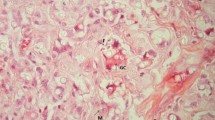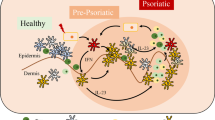Abstract
Porokeratosis is characterized clinically by annular lesions and histologically by the presence of a cornoid lamella (CL) in the epidermis. The underlying mechanism of porokeratosis development remains unclear. We performed immunohistochemical staining of CD1a, langerin, Ki67, CD3, CD4, CD8, FOXP3, and RANKL (receptor activator of nuclear factor κB ligand) in samples from 17 porokeratosis lesions and analyzed the differences in staining patterns among the CL, the inner part of the annular ridge (IC), and the adjacent normal skin (ANS). Numbers of CD1a+ Langerhans cells in the epidermis were reduced and numbers of CD1a+ dermal dendritic cells were significantly increased in the CL and IC compared to those in the ANS. In addition, there was also an increase in FOXP3+ cells in the dermis below the CL and IC. Our findings suggest that Langerhans cells are downregulated in the epidermis in CL and that regulatory T cells and dendritic cells are upregulated in the dermis below the CL. This alteration in the distribution of immune cells, such as various lymphocyte subsets, Langerhans cells, and dermal dendritic cells, may play a key role in the pathomechanisms of porokeratosis.




Similar content being viewed by others
References
Aberer W, Schuler G, Stingl G, Hönigsmann H, Wolff K (1981) Ultraviolet light depletes surface markers of Langerhans cells. J Investig Dermatol 76:202–210
Arranz-Salas I, Sanz-Trelles A, Ojeda DB (2003) p53 alterations in porokeratosis. J Cutan Pathol 30:455–458
Bencini PL, Tarantino A, Grimalt R, Ponticelli C, Caputo R (1995) Porokeratosis and immunosuppression. Br J Dermatol 132:74–78
Cao H, Wang Z, Zhang G (2012) Identification of a locus (DSP2) for disseminated superficial porokeratosis at chromosome 12q21.2–24.21. Clin Exp Dermatol 37:672–676
Chernosky ME, Freeman RG (1967) Disseminated superficial actinic porokeratosis (DSAP). Arch Dermatol 96:611–624
Gu CY, Zhang CF, Chen LJ, Xiang LH, Zheng ZZ (2014) Clinical analysis and etiology of porokeratosis. Exp Ther Med 8:737–741
Kanitakis J (2014) Porokeratoses: an update of clinical, aetiopathogenic and therapeutic features. Eur J Dermatol 24:533–544
Loser K, Mehling A, Loeser S, Apelt J, Kuhn A, Grabbe S, Schwarz T, Penninger JM, Beissert S (2006) Epidermal RANKL controls regulatory T-cell numbers via activation of dendritic cells. Nat Med 12:1372–1379
Luan J, Niu Z, Zhang J (2011) A novel locus for disseminated superficial porokeratosis maps to chromosome 16q24.1–24.3. Hum Genet 129:329–334
Magee JW, McCalmont TH, LeBoit PE (1994) Overexpression of p53 tumor suppressor protein in porokeratosis. Arch Dermatol 130:187–190
Manganoni A, Faccheti F, Gavazzoni R (1989) Involvement of epidermal Langerhans cells in porokeratosis of immunosuppressed renal transplant patients. J Am Acad Dermatol 21:799–801
McGuigan K, Shurman D, Campanelli C, Lee JB (2009) Porokeratosis ptychotropica: a clinically distinct variant of porokeratosis. J Am Acad Dermatol 60:501–503
Nova MP, Goldberg LJ, Mattison T, Halperin A (1991) Porokeratosis arising in a burn scar. J Am Acad Dermatol 25:354–356
Otsuka F, Nashiro K, Kobayashi K, Ishibashi Y (1991) Chromosome abnormalities of porokeratosis-cultured epidermal keratinocytes. Comparison with those of cultured dermal fibroblasts. Cancer Genet Cytogenet 56:163–169
Reed RJ, Leone P (1970) Porokeratosis—a mutant clonal keratosis of the epidermis. I. Histogenesis. Arch Dermatol 101:340–347
Schamroth JM, Zlotogorski A, Gilead L (1997) Porokeratosis of Mibelli. Overview and review of the literature. Acta Derm Venereol 77:207–213
Scholzen T, Gerdes J (2000) The Ki-67 protein: from the known and the unknown. J Cell Physiol 182:311–322
Schwarz A, Bhardwaj R, Aragane Y, Mahnke K, Riemann H, Metze D, Luger TA, Schwarz T (1995) Ultraviolet-B-induced apoptosis of keratinocytes: evidence for partial involvement of tumor necrosis factor-alpha in the formation of sunburn cells. J Investig Dermatol 104:922–927
Shumack S, Commens C, Kossard S (1991) Disseminated superficial actinic porokeratosis. A histological review of 61 cases with particular reference to lymphocytic infiltration. Am J Dermatopathol 23:26–31
Sertznig P, von Felbert V, Megahed M (2012) Porokeratosis: present concepts. J Eur Acad Dermatol Venereol 26:404–412
Tallon B, Blumental G, Bhawan J (2009) Porokeratosis ptychotropica: a lesser-known variant. Clin Exp Dermatol 34:e895–e897
Wing K, Fehérvári Z, Sakaguchi S (2006) Emerging possibilities in the development and function of regulatory T cells. Int Immunol 18:991–1000
Wolf P, Maier H, Müllegger RR, Chadwick CA, Hofmann-Wellenhof R, Soyer HP, Hofer A, Smolle J, Horn M, Cerroni L, Yarosh D, Klein J, Bucana C, Dunner K Jr, Potten CS, Hönigsmann H, Kerl H, Kripke ML (2000) Topical treatment with liposomes containing T4 endonuclease V protects human skin in vivo from ultraviolet-induced upregulation of interleukin-10 and tumor necrosis factor-alpha. J Investig Dermatol 114:149–156
Yoshiki R, Kabashima K, Sugita K, Atarashi K, Shimauchi T, Tokura Y (2009) IL-10-producing Langerhans cells and regulatory T cells are responsible for depressed contact hypersensitivity in grafted skin. J Investig Dermatol 129:705–713
Zhang SQ, Jiang T, Li M (2012) Exome sequencing identifies MVK mutations in disseminated superficial actinic porokeratosis. Nat Genet 44:1156–1160
Zhang ZH, Wang ZM, Crosby ME, Wang HF, Xiang LH, Luan J, Gu CY, Zhou J, Niu ZM, Fang X, Huang W, Zheng ZZ (2008) Gene expression profiling of porokeratosis. J Cutan Pathol 35:1058–1062
Author information
Authors and Affiliations
Corresponding author
Ethics declarations
Conflict of interest
The authors declare that they have no conflict of interest.
Funding
None.
Ethical approval
All procedures performed in our study involving human participants were in accordance with the ethical standards of the institutional research committee and with the 1964 Helsinki declaration and its later amendments or comparable ethical standards.
Informed consent
Informed consent was obtained from all individual participants included in the study.
Rights and permissions
About this article
Cite this article
Matsuyama, K., Mizutani, Y., Takahashi, T. et al. Enhanced dendritic cells and regulatory T cells in the dermis of porokeratosis. Arch Dermatol Res 309, 749–756 (2017). https://doi.org/10.1007/s00403-017-1779-3
Received:
Revised:
Accepted:
Published:
Issue Date:
DOI: https://doi.org/10.1007/s00403-017-1779-3




